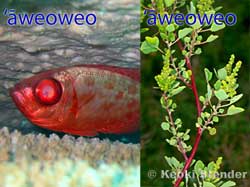Cultural Feature: The Hawaiian concept of duality
The Hawaiian concept of duality permeates throughout all aspects of our culture. This concept serves multiple functions, providing a foundation for a holistic understanding of the natural environment. It also demonstrates the keen observation skills passed down to us from our kūpuna (ancestors) and the relationships we observe among the biotic and abiotic components of the natural world. There are two extremes to everything—light and dark, female and male, land and sea, etc.—whose function is to conceptualize and help us maintain pono (balance). The kuleana (responsibility) of kanaka (humankind) is to maintain this pono in our interactions with the world around us. Many examples of dualisms can be found in the Kumulipo (a cosmogonic genealogy), in which a succession of life forms are born in the ocean and protected by a counterpart on land, both connected in fundamental ways.
An example of one such dualism can be found in comparing the plant and fish who share the common name ʻāweoweo. The meaning of this name can be deciphered by breaking apart the words that comprise the name. ʻĀ refers to a burning fire, weo refers to red or redness. The use of weo twice provides a sense of intensity in the color red that distinguishes the animal and plant to which the name refers. The crater at the summit of Maunaloa on Hawaiʻi Island is named Mokuʻāweoweo, providing us with the imagery of an intense red fire produced by the magma from this volcano. The plant known as ʻāweoweo (Chenopodium oahuense) is an endemic shrub commonly found in coastal to sub-alpine climates in the Main Hawaiian Islands. When the leaves of the plant are crushed, they give off a mild scent of fish, varieties differing in the intensity of this odor. Hawaiians used the wood of this plant to make shark hooks and cooked the leaves for consumption. In the Papahānaumokuākea Marine National Monument (PMNM), this species is found on Lisianski, Laysan, French Frigate Shoals, Mokumanamana, and Nihoa. The fish known as ʻāweoweo (Priacanthus meeki) is endemic to the Hawaiian Archipelago. Juveniles of the species are known as ʻalauā. These fish are nocturnal and feed primarily on zooplankton. The ʻāweoweo is a kinolau (physical manifestation) of the Hawaiian god Lono to whom this fish is provided as an offering. The species is a valuable fisheries resource and vulnerable to overharvesting. In the PMNM, this fish can be found in caves or under ledges, table corals (Acropora sp.) providing a perfect refuge, too.
Plant Information Citation: Duvauchelle, D. 2009 Plant fact sheet for ʻāweoweo (Chenopodium oahuense (Meyen) Aellen). USDA-Natural Resources Conservation Service, Hawaii Plant Materials Center, Hoolehua, Hawaii 96729 Published November, 2009.
Fish Information Citation: Craig, M., Franklin, C. Life history of Hawaiian "redfish": a survey of age and growth in ʻāweoweo (Priacanthus meeki) and uʻu (Myripristis berndti). Hawaii Institute of Marine Biology, P.O. 1346, Kaneohe, HI 96744. Published July, 2008.

